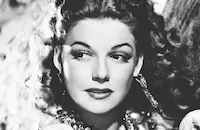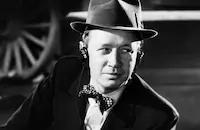Wings for the Eagle

Brief Synopsis
Cast & Crew
Lloyd Bacon
Ann Sheridan
Dennis Morgan
Jack Carson
George Tobias
Russell Arms
Film Details
Technical Specs

Synopsis
In 1941, when more bombers are needed for the Allied war effort, workers from all over the country flock to the Lockheed Aircraft plant in Burbank, California. Among them is Corky Jones, who plans to stay with his old college friend, Brad Maple. Corky has a low draft number and intends to avoid the draft by obtaining a job in the defense industry. Brad is delighted to see Corky again, but his wife Roma is not happy about an additional mouth to feed. Brad, who does not have a job, has spent their savings on a correspondence course in aircraft engineering, only to discover that the school is a fake. The next day, Corky undergoes an extensive security check at Lockheed and soon obtains a job in the storeroom. With an advance against his salary, he buys several bags of groceries as his contribution to the household. Roma is delighted with the food, but Brad is so jealous that Corky moves out. Corky rents a room from German immigrant Jake Hanso, a supervisor at the plant, and his son Pete, Corky's co-worker, who plans to join the air corps upon his graduation from college. Later, Roma leaves Brad and gets a job in the personnel department of the plant. Pleased that she is free, Corky immediately asks her out to dinner. Things grow complicated, however, when Brad also finds employment at the plant. Eventually, the two men come to blows over Roma. At work, Jake asks the workers to donate their services to build an extra bomber, which they will then give to the English soldiers as a Christmas present. Later, Jake is fired because, although loyal to the United States, as an enemy alien, he is not allowed to work in the defense industry. Pete is angered by his father's treatment and abandons his plans to join the air corps. Although saddened by the event, Jake admits that his dismissal is his own fault, as he waited too long to apply for citizenship. Together with Corky, he helps Pete realize that he still wants to fly bombers. Jake then finds work in a diner until his citizenship application is completed. After several months, Pete completes his education and joins the air corps, and Jake becomes a citizen. Father and son vow that one will make the bombers that the other will fly--Hanso to Hanso. Afterward, at home, Corky and the Hansos hear that the Japanese have bombed Pearl Harbor. Pete returns to the base, and Corky and Jake hurry to the plant, where production is stepped up. After the Japanese attack Corky changes his mind about evading the draft. He reunites Roma and Brad and joins the air corps. Then, after Pete is killed in the Philippines, Corky promises Jake that he will down two Japanese bombers in Pete's honor, and does.

Director

Lloyd Bacon
Cast

Ann Sheridan

Dennis Morgan

Jack Carson

George Tobias
Russell Arms

Don Defore
Tom Fadden

John Ridgely
Frank Wilcox

George Meeker

Fay Helm

Billy Curtis
Emory Parnell
Edgar Dearing

Russell Hicks
Dorothy Vaughan
Billy Dawson

Eddie Acuff
Joe Devlin
Robert Winkler
Sonny Bupp
Harry Harvey Jr.
Barry Downing
Ted Oliver
Catherine Lewis
Jean Inness
Victor Zimmerman
Frank Mayo
Charles Sullivan

Frank Ferguson
Creighton Hale
Frank Faylen
Jerry Mandy
Clancy Cooper
Eddie Dew
Jack Gardner
Bill Edwards
Renny Mcevoy

Charles Drake
David Willock

Emmett Vogan
John Maxwell
Kenneth Harlan
Ken Christy
Frank Coghlan Jr.
Ray Montgomery
June Millarde

John Hamilton
Fred Kelsey
Knox Manning
Wen Niles
Sol Gorss
Dick French
Pat Mcvey

Lee Phelps

Walter Sande
Dick Wessel
Eddy Waller

Jack Mower
Crew
Milo Anderson
Hugh Cummings
Leo F. Forbstein
Tony Gaudio
Byron Haskin
Frederick Hollander
H. F. Koenekamp
Robert Lord
Richard Macaulay
Owen Marks
Richard Mayberry
Byron Morgan
B. H. Orkow
Max Parker
Francis J. Scheid
Perc Westmore

Film Details
Technical Specs

Articles
Wings for the Eagle - Wings of the Eagle
Originally titled Shadow of Their Wings, the film was directed by Lloyd Bacon, with a screenplay by Byron Morgan and B.H. Orkow. The original casting had Ronald Reagan co-starring but he was replaced with Morgan and Carson took Morgan's role.
Warner Bros. was given permission to shoot at the Lockheed plant, but each member of the cast and crew had to keep a birth certificate on them at all times for security reasons. The studio hyped up the connection with Lockheed in a full-page ad in Life magazine, dedicating the film "to the workers who actually build Wings for the Eagle. To the workers of America's Fighting aircraft industry...men and women devoted to the new gospel "We can! We must! We Will!"...Warner Brothers respectfully dedicated Wings for the Eagle. Wings for the Eagle is the dramatic, deeply human story of the people of the production lines. All their toil and tears and hard-won joy are in this mightily moving picture. We are deeply grateful to the War Department, to Lockheed Aircraft Corporation, and to all the men and women of Lockheed for their help in making this picture. Behind sentry-barred gates much of it was filmed, without the loss of a single production hour on Lockheed P-38s and Hudsons."
Wings for the Eagle was churned out quickly between January 12 February 1942 at both the Burbank plant and the Curtiss-Wright Aircraft Company in Buffalo, New York. This was the first film that Dennis Morgan and Jack Carson made together. Both vaudevillians, they had met years before in their hometown of Milwaukee, Wisconsin and remained best friends until Carson's death in 1963. During production, Morgan and Carson became close with Ann Sheridan and the three would go on war bond tours together. Later, Morgan and Carson would visit hospitals and camps throughout the South Pacific during the war.
Wings for the Eagle received excellent reviews, with Variety calling it "inspirational without being preachy" and the New York Times reviewer praising both the writers and character actor George Tobias in particular. "Actually the romantic story is no better than the old one of two men and only one girl, a story which the authors casually set aside when they have a point to make. They are more concerned, fortunately, with the urgency of the factory's getting out its quota of bombers under the deadline...Certainly it is the story of Jake, his earnest patriotism and his restrained grief at the death of his son, which takes precedence over Jack Carson and Dennis Morgan's bickerings over the hand of Ann Sheridan-however understandable that may be. And acted by George Tobias, who in a series of steady performances has shown himself one of the best actors on the studio's payroll, the character of Jake becomes the core of the film. Mr. Morgan gives a breezy and friendly performance as the fellow who learns his duty, Mr. Carson is convincing as the husband who must have reached a mental stalemate at the age of 12, and Miss Sheridan continues to toss crisp retorts like flapjacks. If Wings for the Eagle doesn't soar inspiringly it is nevertheless very definitely on the right beam."
Producer: Robert Lord
Director: Lloyd Bacon
Screenplay: Byron Morgan, B.H. Orkow; Richard Macaulay (additional dialogue)
Cinematography: Tony Gaudio
Art Direction: Max Parker
Music: Frederick Hollander
Film Editing: Owen Marks
Cast: Ann Sheridan (Roma Maple), Dennis Morgan (Corky 'Cork' Jones), Jack Carson (Brad Maple), George Tobias (Jake Hanso), Russell Arms (Pete Hanso), Don DeFore (Gil Borden), Tom Fadden (Tom 'Cyclone' Shaw), John Ridgely (Alec Johnson), Frank Wilcox (Supervisor Stark), George Meeker (Personnel Man), Fay Helm (Miss Baxter, Mr. Gross' Secretary), Billy Curtis (Eddie, a Midget), Emory Parnell (Policeman at Garage), Edgar Dearing (Motorcycle Officer).
BW-85m.
by Lorraine LoBianco
SOURCES:
http://aviation-history.suite101.com
http://classicimages.com
http://imdb.com
Lebo, Harlan Casablanca: Behind the Scenes
Life Magazine 17 Aug 42
"The Screen in Review: 'Wings for the Eagle'. Warner's Film Drama of the Men Who Build the Giant Bombers, Is Arrival at Strand Theatre" New York Times 1 Aug 42

Wings for the Eagle - Wings of the Eagle
Quotes
Trivia
Notes
The film begins with the following written dedication: "To our airplane factory workers, whose magnificent efforts will enable the United Nations to preserve a free way of life, this motion picture is respectfully dedicated." The film's working title was The Shadow of Their Wings. News items in Hollywood Reporter add the following information about the production: For the first time since the beginning of the war, the studio received permission to shoot some scenes at Lockheed Aircraft plant in Los Angeles, where the crew filmed bombers waiting to be sent to England by way of Canada. Each member of the film crew was required to carry a birth certificate in order to gain entrance to the plant. Jack Carson replaced Ronald Reagan in the role of "Brad" when the latter was assigned to Desperate Journey. At the time of the film's release, Russell Arms was serving in the United States Army. Although there is a 1942 copyright statement on the film, no record of the picture appears in the Copyright Catalog.















